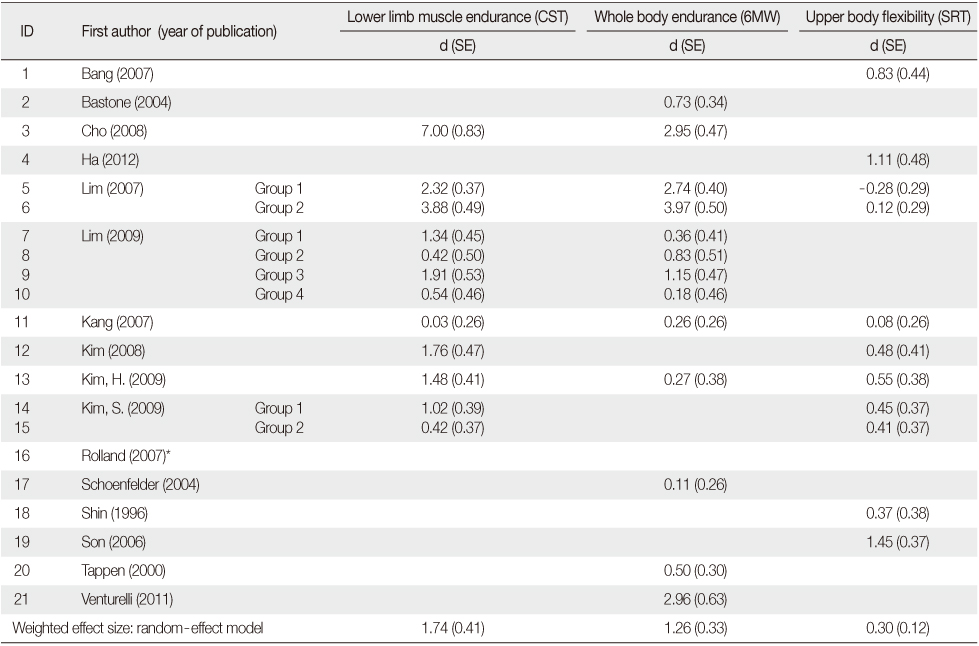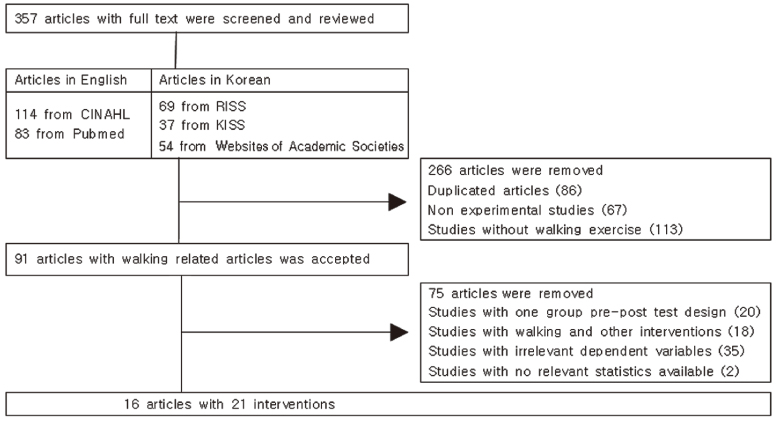Articles
- Page Path
- HOME > J Korean Acad Nurs > Volume 43(4); 2013 > Article
-
Original Article
- A Meta-analysis of the Effect of Walking Exercise on Lower Limb Muscle Endurance, Whole Body Endurance and Upper Body Flexibility in Elders
- Kook-Hee Roh, Hyeoun-Ae Park
-
Journal of Korean Academy of Nursing 2013;43(4):536-546.
DOI: https://doi.org/10.4040/jkan.2013.43.4.536
Published online: August 30, 2013
1Nursing Informatics and Statistics Laboratory, College of Nursing, Seoul National University, Seoul, Korea.
2College of Nursing, Seoul National University, Seoul, Korea.
- Address reprint requests to: Park, Hyeoun-Ae. College of Nursing, Seoul National University, 103 Daehak-ro, Jongno-gu, Seoul 110-799, Korea. Tel: +82-2-740-8827, Fax: +82-2-765-4103, hapark@snu.ac.kr
© 2013 Korean Society of Nursing Science
Abstract
-
Purpose
- The purpose of this study was to determine whether walking exercise improved physical function in elderly people using meta-analysis.
-
Methods
- Medical and nursing literature databases were searched to identify the studies on the effectiveness of walking exercise on physical function. In the databases, there were 16 articles reporting 21 interventions. Overall effect sizes for three outcome variables, elders' physical function in lower limb muscle endurance, whole body endurance and upper body flexibility, were calculated. Effects of study characteristics on outcome variables were analyzed.
-
Results
- The meta-analysis showed that walking exercise generally had positive effects on CST (chair stand test), 6MW (6 min walking), and SRT (standing or sitting reach test) with overall weighted effect sizes of 1.06, 0.41 and 0.29 respectively. This study also showed that the chronic disease status of the elders, intervention methods, and type of residence had different effects on CST, 6MW and SRT.
-
Conclusion
- The results indicate that walking exercise improves physical function in elders. Walking exercise which can be done at any time and any location is indeed a very effective exercise for elderly people.
- 1. Cohen J. Statistical power analysis for the behavioral sciences. New York, NY: Academic Press; 1977.
- 2. Daley MJ, Spinks WL. Exercise, mobility and aging. Sports Med. 2000;29(1):1–12.ArticlePubMed
- 3. Bastone Ade C, Jacob Filho W. Effect of an exercise program on functional performance of institutionalized elderly. J Rehabil Res Dev. 2004;41(5):659–668. http://dx.doi.org/10.1682/JRRD.2003.01.0014ArticlePubMed
- 4. Gregg EW, Cauley JA, Stone K, Thompson TJ, Bauer DC, Cummings SR, et al. Relationship of changes in physical activity and mortality among older women. JAMA. 2003;289(18):2379–2386. http://dx.doi.org/10.1001/jama.289.18.2379ArticlePubMed
- 5. Gu MO, Conn VS. Meta-analysis of the effects of exercise interventions on functional status in older adults. Res Nurs Health. 2008;31(6):594–603. http://dx.doi.org/10.1002/nur.20290ArticlePubMed
- 6. Ha MS, Kwak YS, Ji JG. The effects of aerobic exercise on flexibility, MDA and SOD in musculoskeletal disease patients. Exerc Sci. 2012;21(3):365–372.Article
- 7. Hedges LV, Olkin I. Statistical methods for meta-analysis. Orlando, FL: Academic Press; 1985.
- 8. Heyn P, Abreu BC, Ottenbacher KJ. The effects of exercise training on elderly persons with cognitive impairment and dementia: A meta-analysis. Arch Phys Med Rehabil. 2004;85(10):1694–1704.PubMed
- 9. Jadad AR, Moore RA, Carroll D, Jenkinson C, Reynolds DJ, Gavaghan DJ, et al. Assessing the quality of reports of randomized clinical trials: Is blinding necessary? Control Clin Trials. 1996;17(1):1–12.ArticlePubMed
- 10. Jung YS. A meta analysis of the effects of exercise programs in the elderly. Seoul, Ewha Womans University. 2006;Unpublished doctoral dissertation.
- 11. Kang JS. Effects of a regular walking exercise on functional improvement in the Korean elderly. Seoul, Yonsei University. 2007;Unpublished master's thesis.
- 12. Kim BY. The effects of walking exercise during 12 weeks on the cardiorespiratory function and physical fitness in elderly women. J Sport Leis Stud. 2008;33(2):851–862.Article
- 13. Kim SH. Effects of intermittent walking for health related physical fitness and metabolic syndrome risk factors in elderly women. J Korean Gerontol Soc. 2009;29(4):1397–1411.
- 14. Kim SY, Park JE, Seo HJ, Lee YJ, Jang BH, Son HJ, et al. NECA's guidance for undertaking systematic reviews and meta-analyses for intervention. Seoul: National Evidence-based Healthcare Collaborating Agency; 2011.
- 15. Korea Institute of Sport Science. Exercise prescription. Seoul: 21st Publishing; 2000.
- 16. Lee EO, Song HH, Lee BS, Kim JH, Lee EH, Lee EJ, et al. Effects nursing interventions on anxiety and / or stress: A meta-analysis. J Nurs Acad Soc. 1992;22(4):526–551.ArticlePDF
- 17. Lim HJ, Kim YS, Cho HS, Kim CH, Lim HJ, Jeong HS, et al. Effects of regular walking exercise on health-related parameters in persons with chronic diseases. J Life Sci. 2009;19(12):1750–1757.Article
- 18. Lipsey MW, Wilson DB. Practical meta-analysis. California: Sage Publications; 2001.
- 19. National Institute for Health and Clinical Excellence. Methods for development of NICE public health guidance. London, UK: Author; 2006.
- 20. Roh KH, Park HA. A meta-analysis on the effectiveness of computer-based education in nursing. Healthc Inform Res. 2010;16(3):149–157. http://dx.doi.org/10.4258/hir.2010.16.3.149ArticlePubMedPMC
- 21. Rolland Y, Pillard F, Klapouszczak A, Reynish E, Thomas D, Andrieu S, et al. Exercise program for nursing home residents with Alzheimer's disease: A 1-year randomized, controlled trial. J Am Geriatr Soc. 2007;55(2):158–165. http://dx.doi.org/10.1111/j.1532-5415.2007.01035.xArticlePubMed
- 22. Schoenfelder DP, Rubenstein LM. An exercise program to improve fall-related outcomes in elderly nursing home residents. Appl Nurs Res. 2004;17(1):21–31.ArticlePubMed
- 23. Shin YH. The effect of walking exercise program on physical function and emotional state in elderly women. Seoul, Ewha Womans University. 1997;Unpublished doctoral dissertation.
- 24. Son JU, Lee JH. The effect of the walking exercise on physiological index, physical fitness, self esteem, depression and life satisfaction in the institutionalized elderly women. J Korean Acad Community Health Nurs. 2006;17(1):5–16.
- 25. Song HH. Meta-analysis. Paju: Cheong Moon Gak Publisher; 1998.
- 26. Statistics Korea. Government statistics of elderly in 2010. Daejeon: Author; 2010.
- 27. Sung KW. Content analysis of exercise programs for the elderly in Korean and foreign articles. J Korean Acad Community Health Nurs. 2007;18(1):156–168.
- 28. Tappen RM, Roach KE, Applegate EB, Stowell P. Effect of a combined walking and conversation intervention on functional mobility of nursing home residents with Alzheimer disease. Alzheimer Dis Assoc Disord. 2000;14(4):196–201.ArticlePubMedPMC
- 29. Venturelli M, Scarsini R, Schena F. Six-month walking program changes cognitive and ADL performance in patients with Alzheimer. Am J Alzheimers Dis Other Demen. 2011;26(5):381–388. http://dx.doi.org/10.1177/1533317511418956ArticlePubMedPMCPDF
REFERENCES

*Rolland (2007) was removed for further analysis because it had missing values. d (SE)=Effect size (Standard error); RCT=Randomized controlled trial; NRCT=Non-randomized controlled trial. Rolland (2007), Kim, S. (2009), and Venturelli (2011) are random controlled trials, and the remaining 13 are non-random controlled trials.

Study 3,5,6,and 11 were removed for CST; 3,5,6, and 21 were removed for 6MW; 19 was removed for SRT. *Number of the effect size; †Mean effect size weighted by the inverse of their effects variance; ‡95% confidence interval; §Binomial effect size display; ∥Total effect size (p); ¶Homogeneity statistics; #Fail-safe number.
Figure & Data
REFERENCES
Citations

- Effects of Protein Intake and Physical Activity on Hand Grip Strength in the Older Adults Aged over 65 Years of Age: Using Data from the 7th Korea National Health and Nutrition Examination Survey
Do-Yeon Kim, Byung-Sun Choi
Korean Journal of Geriatrics & Gerontology.2025; 26(1): 23. CrossRef - Objectively measured the impact of ambient air pollution on physical activity for older adults
Jiali Cheng, Yin Wu, Xiaoxin Wang, Hongjun Yu
BMC Public Health.2024;[Epub] CrossRef - Effects of walking exercise on cognitive and physical functions: meta-analysis of older adults
Mi Jin Lee, Hee Ju Ro, Jung Kee Choi, So Yeon Kim
Forest Science and Technology.2024; 20(2): 201. CrossRef - A Meta-Analysis of the Effects of Walking Exercise on Depression
Jonghwa Lee, Youngho Kim
The Asian Journal of Kinesiology.2023; 25(4): 12. CrossRef - Effect of Aerobic, Resistance, and Combined Exercise Training on Depressive Symptoms, Quality of Life, and Muscle Strength in Healthy Older Adults: A Systematic Review and Meta-Analysis of Randomized Controlled Trials
Ahmad Mahmoudi, Farahnaz Amirshaghaghi, Reza Aminzadeh, Ehsan Mohamadi Turkmani
Biological Research For Nursing.2022; 24(4): 541. CrossRef - Multimorbidity and associations with clinical outcomes in a middle-aged population in Iran: a longitudinal cohort study
Maria Lisa Odland, Samiha Ismail, Sadaf G Sepanlou, Hossein Poustchi, Alireza Sadjadi, Akram Pourshams, Tom Marshall, Miles D Witham, Reza Malekzadeh, Justine I Davies
BMJ Global Health.2022; 7(5): e007278. CrossRef - Effects of a Physical Exercise Program on Physiological, Psychological, and Physical Function of Older Adults in Rural Areas
Sunmi Kim, Eun-Jee Lee, Hyeon-Ok Kim
International Journal of Environmental Research and Public Health.2021; 18(16): 8487. CrossRef - Comparison of the Effects of Education Only and Exercise Training Combined with Education on Fall Prevention in Adults Aged 70 Years or Older Residing in Elderly Residential Facilities
Chahwa Hong, Haejung Lee, Misoon Lee
Journal of Korean Academy of Nursing.2021; 51(2): 173. CrossRef - The Effects of Forest Healing Anti-aging Program on Physical Health of the Elderly: A Pilot Study
Ji-Eun Baek, Ho-jin Shin, Sung-Hyeon Kim, Jae Yeon Kim, Sujin Park, Si-Yoon Sung, Hwi-young Cho, Suk-Chan Hahm, Min-Goo Lee
Journal of The Korean Society of Physical Medicine.2021; 16(2): 81. CrossRef - Factors Influencing Health-Related Quality of Life in the Korean Seniors with Lower Education Level: Focusing on Physical Activity Types
Hye Young Choi, Guna Lee
Korean Journal of Adult Nursing.2020; 32(3): 292. CrossRef - Evaluation of the Interaction Model of Client Health Behavior‐based multifaceted intervention on patient activation and osteoarthritis symptoms
Yang Heui Ahn, Ok Kyung Ham
Japan Journal of Nursing Science.2020;[Epub] CrossRef - The Effects of Sand Exercise Program on Balance Capability, Extremity Muscle Activity, and Inflammatory Markers in Older Women
Sung-Soo Lee, Yong-Seok So
Exercise Science.2019; 28(2): 131. CrossRef - Physical activity in older age: perspectives for healthy ageing and frailty
Jamie S. McPhee, David P. French, Dean Jackson, James Nazroo, Neil Pendleton, Hans Degens
Biogerontology.2016; 17(3): 567. CrossRef - Literature Review for the Effects of Physical Activity on Musculoskeletal Outcomes in Community-dwelling Older Adults
Kyung Choon Lim, Jeung-Im Kim, Young Ran Chae
Korean Journal of Women Health Nursing.2014; 20(4): 297. CrossRef

Figure 1
A List of Articles Used in the Meta-Analysis
DM=Diabetes mellitus; IFG=Impaired fasting glucose; AD=Alzheimer's disease; Wks=Weeks; CST=Chair stand test; 6MW=6 min walking; SRT=Standing or sitting reach test.
Effect Size of CST, 6MT, and SRT by Individual Study
*Rolland (2007) was removed for further analysis because it had missing values. d (SE)=Effect size (Standard error); RCT=Randomized controlled trial; NRCT=Non-randomized controlled trial. Rolland (2007), Kim, S. (2009), and Venturelli (2011) are random controlled trials, and the remaining 13 are non-random controlled trials.
Weighted Effect Size of CST, 6MT and SRT: Fixed-effect Model
Study 3,5,6,and 11 were removed for CST; 3,5,6, and 21 were removed for 6MW; 19 was removed for SRT. *Number of the effect size; †Mean effect size weighted by the inverse of their effects variance; ‡95% confidence interval; §Binomial effect size display; ∥Total effect size (p); ¶Homogeneity statistics; #Fail-safe number.
Comparison of Weighted Effect Sizes of CST, 6MW and SRT by Study Characteristics: Fixed-effect Model
DM=Diabetes mellitus; IFG=Impaired fasting glucose; AD=Alzheimer's disease; Wks=Weeks; CST=Chair stand test; 6MW=6 min walking; SRT=Standing or sitting reach test.
*Rolland (2007) was removed for further analysis because it had missing values. d (SE)=Effect size (Standard error); RCT=Randomized controlled trial; NRCT=Non-randomized controlled trial. Rolland (2007), Kim, S. (2009), and Venturelli (2011) are random controlled trials, and the remaining 13 are non-random controlled trials.
Study 3,5,6,and 11 were removed for CST; 3,5,6, and 21 were removed for 6MW; 19 was removed for SRT. *Number of the effect size; †Mean effect size weighted by the inverse of their effects variance; ‡95% confidence interval; §Binomial effect size display; ∥Total effect size (
 KSNS
KSNS
 E-SUBMISSION
E-SUBMISSION



 Cite
Cite

